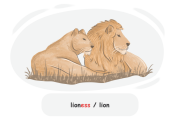Gender-Specific Nouns
Dive into gender-specific nouns with detailed explanations. Examples include 'waiter' and 'waitress', and a quiz to test your knowledge.

Nouns Categorization Based on Gender
The gender of a noun is not necessarily related to the biological gender of the person or object it represents, but is a grammatical feature of the language. Based on gender, nouns can be categorized into two main categories: Gender-specific Nouns and Genderless Nouns.
What Are Gender-Specific Nouns?
Unlike some other languages, English does not assign genders to all nouns. There are a few exceptions, however, where gender-specific words refer to people or animals of a specific gender, such as "man" or "woman," "boy" or "girl." When using gender-specific nouns, it is important to be aware of the gender of the individual being referred to and use the appropriate noun.
Gender-Specific Nouns: Types
Gender-specific nouns can be categorized into different groups:
General gendered human nouns
Gendered family relations
Gendered job titles
Gendered ceremonial titles
Gendered animal nouns
M | F |
|---|---|
man | woman |
boy | girl |
husband | wife |
grandfather | grandmother |
uncle | aunt |
waiter | waitress |
actor | actress |
prince | princess |
king | queen |
lion | lioness |
stallion | mare |


Gender-Inclusive Nouns
In recent years, there has been a growing awareness of the importance of gender-inclusive language in English, which aims to be more inclusive of people who do not identify as male or female. One way to achieve this is through the use of gender-inclusive nouns, which are words that do not have a gendered connotation or can be used to refer to people of any gender.
M | F | Inclusive |
|---|---|---|
Man | Woman | person |
Son | Daughter | child |
Waiter | Waitress | server |
Steward | Stewardess | Flight attendant |
Landlord | Landlady | Property owner |
Policeman | Policewoman | Police officer |
Tip!
When using pronouns to substitute for nouns, it is important to use pronouns that correspond with the gender of the noun. For example, to refer back to a female gender-specific noun "she/her" must be used while "he/him" are used to refer back to male gender-specific nouns. In cases where a gender-inclusive noun is used to refer to a person or when referring to individuals whose gender is unspecified, gender-neutral pronouns such as "they/them" or "one"can be used.
When a person applies for a job, they should include their resume and cover letter.
One can never be too careful when handling delicate items.
Genderless Nouns
Genderless nouns are those that do not have a particular gender assigned to them. These nouns are neutral and do not refer to any particular gender. The majority of nouns in English are genderless, and they include words like "table," "book," "car," and "computer." Unlike gender-specific nouns, which may require specific pronouns or adjectives, genderless nouns do not require any changes to the words used to describe or modify them.
Tip!
Keep in mind that in English, nouns are considered genderless unless they are explicitly referring to a male or female person or animal. So, if you are not sure whether a noun is masculine or feminine, you should treat it as genderless. For example, 'my doctor' can be a man or a woman. Or 'her chicken' could be either a rooster or a hen.
Using the Genderless Pronoun "it"
In English, the neuter pronoun "it" is mainly used to refer to inanimate things or objects that do not have a specific gender. For example, "it" can be used to refer to a book, a table, or a computer. However, "it" can also be used to refer to animals or babies, which can be controversial as it can be seen as dehumanizing or disrespectful. Using "it" to refer to a person can be seen as offensive or insensitive.
My cat sleeps in its box when it feels sleepy.
'Cat' is a genderless noun, 'its' is a neuter possessive determiner and 'it' is a neuter pronoun.
Warning
When a word like 'doctor' refers to a person whose gender is unspecified, we cannot use neuter pronouns or possessive determiners to refer to that person. In such cases, using the singular 'they' is the most acceptable way of talking about a genderless noun referring to a person.
Ask your doctor if they want to try a different treatment.
Review
While most nouns in English are non-gendered, there are some nouns that specifically refer to a particular gender. These nouns might represent the gender of people in terms of family relations, their job or ceremonial titles, or a more general sense of femininity or masculinity. In many cases, there are gender-inclusive nouns that cover both genders.
Male | Female | Gender-inclusive |
|---|---|---|
man | woman | person |
father | mother | parent |
husband | wife | spouse |
businessman | businesswoman | businessperson |
Quiz:
Select all gender-specific nouns from the list. (Select five.)
hen
teacher
husband
aunt
bird
scientist
queen
house
cat
stallion
Which of the following sentences uses a gender-inclusive noun correctly?
The waiter brought our drinks promptly.
Each student should submit his homework by Friday.
The flight attendant ensured they had all passengers' boarding passes.
My aunt and uncle visited their grandmother.
Fill the table by choosing the correct category for each noun.
Server | |
Uncle | |
Actress | |
Niece | |
Doctor | |
Spouse | |
Bull |
Match each gender-specific noun in Column A with its gender-inclusive equivalent in Column B.
Which of the following sentences correctly uses a genderless noun and an appropriate pronoun?
The doctor said he will arrive at noon.
My cat chases her tail all day.
The table is missing its leg.
A baby should never be left alone; it needs constant care.
Comments
(0)